External walls of their design and purpose. Walls of buildings and their elements
By the walls
By location - external and internal.
Exterior walls - the most complex building structure. They are subjected to numerous and varied force and non-force influences. Interior walls are divided into:
Interroom;
26. General requirements and classification of walls.
By the walls called the vertical structural elements of the building, separating the premises from the external environment and dividing the building into separate rooms. They perform enclosing and bearing (or only the first) functions. They are classified according to various criteria.
By location - external and internal.
Exterior walls - the most complex building structure. They are subjected to numerous and varied force and non-force influences. Walls perceive their own mass, permanent and temporary loads from ceilings and roofs, the effects of wind, uneven deformations of the base, seismic forces, etc.
On the outside, the outer walls are exposed to solar radiation, atmospheric precipitation, variable temperatures and humidity of the outside air, external noise, and on the inside, the effects of heat flux, water vapor flux, noise. Acting as an external building envelope and a composite element of facades, and often supporting structure, the outer wall must meet the requirements of strength, durability and fire resistance, corresponding to the capital class of the building, protect the premises from adverse external influences, provide the necessary temperature and humidity conditions of the enclosed spaces, have decorative qualities.
The design of the outer wall must meet the requirements of the economic requirements of minimum material consumption and cost, since the outer walls are the most expensive structure (20-25% of the cost of building structures).
The outer walls usually have window openings for lighting rooms and doorways - entrance and exit to balconies and loggias. Temperature seams arrange to avoid the formation of cracks and distortions in the walls caused by the concentration of forces from exposure to variable temperatures and shrinkage of the material (masonry, monolithic or prefabricated concrete structures, etc.). Often they are called temperature-shrink. Shrink joints cut through the structure of only the ground part of the building. Distances between heat-shrinkable joints are assigned in accordance with climatic conditions and physicomechanical properties of wall materials. Sedimentary seams it should be provided in places of sharp changes in the number of storeys of the building (sedimentary seams of the first type), as well as with significant unevenness of deformations of the base along the length of the building caused by the specifics of the geological structure of the base (sedimentary seams of the second type). Sedimentary joints of the first type are used to compensate for differences in the vertical deformations of the ground structures of the high and low parts of the building, in connection with which they are arranged similarly to temperature-shrinkage only in ground structures. Sedimentary seams of the second type cut the building to the entire height - from the ridge to the base of the foundation. Antiseismic seams should be provided in buildings erected in areas with seismicity of 7 points or more. The distance between the anti-seismic seams should not exceed 60 m. The anti-seismic seams should also be arranged in places of change in the number of storeys and in buildings of complex shape in plan to be divided into independent symmetrical compartments.
The design of the anti-seismic seam should ensure compartment compartments.
Expansion joints in frame-panel buildings are separated by paired columns.
The minimum length (width) of the temperature compartment of the frame-panel building should be 60 m.
Interior walls are divided into:
Interroom;
In-house (walls and partitions);
Walls with ventilation ducts (near the kitchen, bathrooms, etc.).
Depending on the adopted structural system and building scheme, the external and internal walls of the building are divided into bearing, self-supporting and non-bearing. Partitions
Bearing
Self-supporting
Non-bearing
Partitions- These are vertical, as a rule, non-load-bearing fences, dividing the internal volume of the building into adjacent rooms.
They are classified according to the following criteria:
By location - interior, interroom, for kitchens and plumbing units;
By function - deaf, with openings, incomplete, that is, not reaching
By design - solid, frame, sheathed on the outside with sheet material;
By the installation method - stationary and transformable.
Partitions must meet the requirements of strength, stability, fire resistance, sound insulation, etc.
Bearing walls, in addition to the vertical load from their own mass, are perceived and transferred to the foundations of the load from adjacent structures: ceilings, partitions, roofs, etc. (Table 5.1).
Self-supporting the walls perceive the vertical load only from their own mass (including the load from balconies, bay windows, parapets and other wall elements) and transfer it to the foundations directly or through basement panels, randbalks, grillage or other structures.
Non-bearing the walls are floor-by-floor (or through several floors) supported by adjacent internal structures of the building (floors, walls, frame).
27. Architectural and structural details of the walls.
On the outer surface of the walls distinguish horizontal and vertical divisions architectural and structural details and elements.
Horizontal division form a base, cornices, belts, and vertical - splitting, risalits, pilasters, niches, columns and half columns and other elements.
Base called the lower part of the building, located directly above the foundation (Fig. 5.4, a ... n).
Structural elements that protect the walls of buildings from rain and melt water are cornices (Fig. 5.4, d, d ).
Cornices there are crowning and intermediate . The cornice as an architectural element of the building can affect the expressiveness of the facade.
Over the window and doorways arrange ledges - sandriks (Fig. 5.5, 6). which are also architectural decorations. Around the window and doorways are sometimes arranged platband and (Fig. 5.5, e).Often they are made of special shaped elements. In some cases, the exterior wall of the building is led slightly above the cover; this part of the wall is called parapet.
Large elements that have both functional and architectural purposes are balconies, loggias, bay windows .
Balconies represent a platform consisting of a balcony slab and a fence (Fig. 5.6, a ).
Bay window they call the enclosed part of the room, which extends beyond the outer plane of the facade wall and is usually illuminated by several windows (Fig. 5.6, b ). Bay windows enrich not only the general solution of the facades, but also their spatial and spatial structure.
Niche called the local recess in the wall, pilaster - elongated vertically and slightly wider local thickening of the wall.
Column - this is a separate pillar support, half column - a pilaster protruding from the plane of the wall at half its width. Columns and half columns, as a rule, carry load-bearing functions
Loggia It is an open space built into the dimensions of the building, protruding (partially or completely) from the plane of the outer walls (Fig. 5.6, c). By design, there are three types of loggias: sunken, fully placed in the dimensions of the building, partially sunk and remote.
External walls are not only structural elements, their outer side is an element of the building's facade. Therefore, walls (their configuration, vertical and horizontal articulations, proportions of individual elements, plinths, cornices, decoration, etc.) determine the nature of the architecture and tectonics of the building. At the same time, the facade does not exist regardless of the purpose of the building, its planning structure, materials and structures of the external walls, but is their reflection.
Impact on the wall. Both external and internal walls of buildings are exposed to a number of factors that are closely related to the processes taking place inside and outside the building.
Power actions include:
Load from floors and coatings (roofs);
The load from uneven soil deformation (precipitation, swelling);
Seismic effects.
Non-force impacts are:
Precipitation;
Water vapor contained in indoor air;
Soil moisture;
Solar radiation;
Outside temperature, its differences;
Aggressive substances contained in the air;
Airborne noise outside and inside the building.
Walls must satisfy the following requirements:
To be strong and steady;
Have a durability corresponding to the class of the building;
Corresponding to the degree of fire resistance of the building;
Be an energy-efficient building element;
Meet the requirements of air and sound insulation;
To be industrial in order to increase labor productivity;
Possess, if possible, the minimum mass and material consumption;
Respond with modern architectural and artistic quality;
Be economical in the process of construction and operation.
Accounting for all modern requirements caused the need to divide the outer walls into separate layers for the intended purpose. The walls have become multi-layered, consisting of functionally separated elements: the load-bearing capacity is provided by a stronger structural layer, protection against cooling or overheating - an unstable, but highly effective heat-insulating layer and, finally, giving a good look - finishing layers.
Interior walls are designed from the conditions of strength and sound insulation. These two requirements coincide in their physical properties, the denser the material of the inner wall, the more durable and less sound conductive.
However, here, layered structures with alternating dense and loose layers are more effective in sound insulation, which in each individual case should be established by calculation.
The architect’s task is to develop a solution in which the wall materials and their construction would satisfy, if possible, all the requirements for them and contribute to obtaining the most optimal solution. In the design process, the following basic prerequisites:
Climatic factors of the construction area (outdoor temperature in winter and summer, precipitation, wind speed, insolation);
Nomenclature of available building materials;
Technical capabilities of construction and installation enterprises;
Special construction conditions (seismic, soil, etc.);
Classification of walls. Depending on the perception of loads, the walls of buildings can be load-bearing, self-supporting and non-bearing.
According to the situation in the building the walls are divided into domestic and outdoor (around the perimeter of the building).
By the nature of the main material supporting and self-supporting walls can be wooden, stone, concrete, combined. For walls use the following basic materials and products:
Wood (logs, beams, boards, panels);
Burnt clay (brick, stones);
Silicate mass (brick);
Natural stone;
Stabilized soil (blocks);
Lightweight concrete (stones, blocks, panels, monolith);
Aerated concrete (stones, blocks, monolith);
Heavy concrete (panels, monolith).
Depending on the type and size used wall products are:
- from small-sized wall products - bricks, stones, small blocks;
- coarse - from wall elements with a height of 1/4 to the full height of the floor and more; large-element walls are divided into large-block and large-panel ones.
According to the method of construction distinguish masonry walls (assembly) of small pieces, prefabricated, monolithic, precast monolithic.
By design the walls are single layer (usually internal) and layered, solid and hollow.
By the presence and location of thermal insulation external walls are divided into:
- walls without a special thermal insulation device - from structural and heat-insulating materials (wood, wood concrete, cellular concrete, polystyrene concrete);
- walls with insulating layerslocated inside the wall, on the outer side of the structural layer of the wall, on the outer and inner sides together.
By the presence of a special air gap (interlayers) walls are divided into:
- ventilated - with air gaps located either inside the structural layer (between the structural layers), or between the insulation and the protective lining;
- unventilated - without air gap.
Buildings of the wall constructive system can be solved in a wide variety of options (schemes) by location bearing walls - transverse and longitudinal, internal and external, rectilinear and curvilinear, parallel, radial, concentric, etc. to the walls.
The design process should be considered as source following basic prerequisites:
Climatic factors of the construction area (summer and winter outdoor temperatures, precipitation, wind speed, insolation);
Special construction conditions (part-time, seismic, ground, etc.);
Characteristics of the building (purpose, number of storeys, degree of fire resistance, temperature and humidity conditions, etc.);
Technical capabilities of construction organizations;
Financial capabilities of the customer.
Walls (vertical fences) can be load-bearing and, when they, besides their own gravity, perceive the load from other parts of the building; self-supporting if they bear the load only from the own gravity of the walls of all floors of the building; not bearing (mounted), when they perceive their own weight only within one floor.
Fig. 1. Architectural and structural elements of the walls: 1 - basement; 2 - cordon; 3 - saydrnk; 4 - window sill; 5 - main cornice: 6 - corner wall; 7 - intermediate cornice; 8 - wall; 9 - jumper; 10 - window opening; 11 - pediment; / 2-cornice; 13 - doorway; 14 - pilaster; 15 - buttress; 16 - parapet; 17-edged walls; 18 niche; 19 - ripping.
External walls, being the main structural and architectural elements of the building, form its facades: main, side, rear.
The walls must be strong, stable, have sufficient heat and sound insulation properties, be safe in fire. In addition, the walls should be frost-resistant, moisture-proof and bio-resistant, have a minimum weight and the lowest cost.
The walls are stone and wooden. Stone walls can be laid out of bricks, stone blocks, lightweight concrete small-sized stones, ceramic stones, large-sized elements (panels or large blocks).
A wall usually consists of a basement, piers, openings, cornices, trimmings and other parts (Fig. 1).
The basement of the walls is laid out from ordinary burnt clay brick.
To block openings in brick walls, prefabricated reinforced concrete lintels are most common.
Cornices are made with a small removal (not more than 1/2 of the wall thickness) from the same brick as the masonry of the wall, with a gradual release of the rows of masonry. With the removal of more than 300 mm, the cornice is made of reinforced concrete slabs.
Walls of stone blocks. The nature of the masonry walls made of stone blocks, lightweight concrete small stones and ceramic stones does not differ significantly from masonry. Only the wall thickness and the stone dressing system change.
Wooden walls are divided into log chopped, cobblestone, frame, shield.
Log walls are made of logs (220-260 mm thick in the upper cut) laid in horizontal rows with notches in the corners.
Cobble walls are made of horizontally laid Wooden beams with a section of 180X180 or 150 × 150 mm.
Frame walls require less wood and labor. Saving wood is achieved by the fact that the frame, which carries the bearing functions, consists of racks or poles, girders, braces, if necessary, reinforcing stiffness, and fencing and thermal insulation is a filler of various insulation (slag, sawdust, slag, etc.). The insulation from the outside and inside is sheathed by boards.
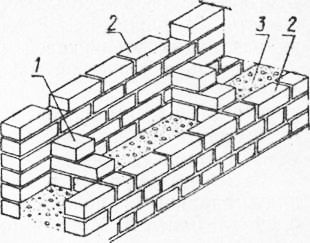
Fig. 2. Lightweight brick wall with masonry: 1 - transverse brick wall: 2 - external and internal longitudinal walls of 1/2 brick; 3 - insulation.
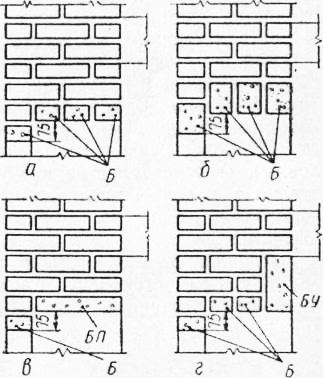
Fig. 3. Prefabricated reinforced concrete lintels: a - squared section of 65X120 mm (type B); b-squared section 140X120 mm (type B); c - slab slice 65X580 mm (type BP); g - squared section 220X120 mm (type BU).
Shield walls consist of enlarged parts - shields procured at factories. Construction is reduced only to installation and decoration.
Walls of large elements. The most economical and industrial are the walls of large elements - blocks and panels. Their installation is carried out using cranes.
Large blocks are made in factories from light concrete (cinder concrete, expanded clay concrete, cellular concrete, etc.).
The thickness of the block is taken equal to the wall thickness - 400, 500 and 600 mm.
The main structural scheme of buildings of large blocks is a scheme with external and internal load-bearing walls. The spatial rigidity of these buildings is ensured by the transverse wall system. The method of dividing the wall into individual blocks is called cutting, the most common two-row cutting. Blocks are wall, jumpers, window sills, blocks of internal walls.
The most vulnerable spot in block (as in large-panel) construction is the joints. They need to be carefully sealed with various materials (sealants, rubber or polymer gaskets, solution grease).
A large wall panel is an element of a larger area and smaller thickness compared to a large wall block. Figure 15 shows the most common type of panel and the interface between the outer and inner panels.
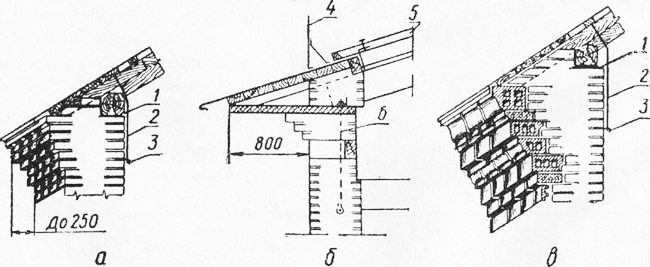
Fig. 4. Some types of eaves structures: 1 - type-setting of brick, with a small extension; b - from a reinforced concrete slab, with a large extension; c - from ceramic curly face stones (1-Mauerlat; 2 - twist, 3-pin, 4 - fencing, 5 -roof, 6 - anchor).

Fig. 5. Wall from single-layer expanded clay concrete panels: a - panel structure; b - conjugation of the external panel with the internal; in the same, internal to each other (1 - a lifting loop, 2 - a temperature seam, 3 - a heating panel, 4 effective heater. 5 - a finishing layer, b - decorative concrete, - steel connecting rods, 8 - embedded steel parts, 9 - panel of the inner wall, 10 - the same as the outer wall).
Wall panels come to the construction site almost completely finished, tiled with ceramic or glass tiles, painted or prepared for painting.
In the housing construction of the USSR, the most common structural schemes with load-bearing walls. In this case, cut the outer walls and panels of 1 or 2 rooms in size.
Panels of internal walls, partitions and ceilings make the size of the room.
Wall panels are made of lightweight concrete or reinforced concrete using effective heaters. They are single-layer (from light concrete) and a layered structure (from reinforced concrete).
Balconies, bay windows, loggias. Elements of the walls are also balconies, consisting of a bearing plate and fencing; bay windows, which are part of the room, which protrudes beyond the plane of the facade of the building; loggias, balconies, built into the dimensions of the building.
Walls are the main supporting and enclosing structures of the building. They must be strong, tough and stable, possess the required fire resistance and durability, be low heat conductive, heat resistant, sufficiently air and soundproof, as well as economical.
Basically, external influences on buildings are perceived by roofs and walls (Fig. 2.13).
Three parts are distinguished by the wall: the lower is the base, the middle is the main field, the upper is the entablature (cornice).
Figure 2.13 External influences on the building: 1 - permanent and temporary vertical power influences; 2 - wind; 3 - special force effects (seismic or others); 4- vibration; 5 - lateral soil pressure; 6- soil pressure (rebuff); 7 - ground moisture; 8 - noise; 9 - solar radiation; 10 - precipitation; 11 - state of the atmosphere (variable temperature and humidity, the presence of chemical impurities)
By the nature of perception and transmission of loads walls (external and internal) are divided into load-bearing, self-supporting and hinged (with a supporting frame) (Fig. 2.14). Bearing walls should provide strength, rigidity and stability of the building from the effects of wind loads, as well as loads attributable to floors and coatings, transferring the arising forces through the foundations to the base. Self-supporting walls must maintain their strength, rigidity and stability when exposed to wind loads, their own weight and the overlying part of the wall. Curtain walls, designed only to protect the premises from atmospheric influences (cold, noise), are constructed using highly efficient heat-insulating materials with lightweight multilayer materials. They usually transfer the load (wind) within the same panel and from their own weight to the elements of the supporting frame of the building.
By the nature of accommodation in the building they distinguish between external walls, that is, enclosing a building, and internal walls that divide rooms.
By type of materials used the walls can be wooden (log, cobblestone, frame-panel, etc.), made of stone materials, concrete, reinforced concrete, as well as multilayer (using high-performance heat-insulating materials as a heat insulating layer).
The main parts of the external walls are plinths, openings, piers, lintels, pilasters, buttresses, pediment, cornices and parapets (Fig. 2.14). Basement - the lower part of the wall adjacent to the foundation. The walls have openings for windows, doors and gates. The sections of the walls between the openings are called piers, over the openings - jumpers. The crowning cornice is the upper protruding part of the wall. Parapet - part of the wall enclosing the roof in buildings with an internal drainage system.
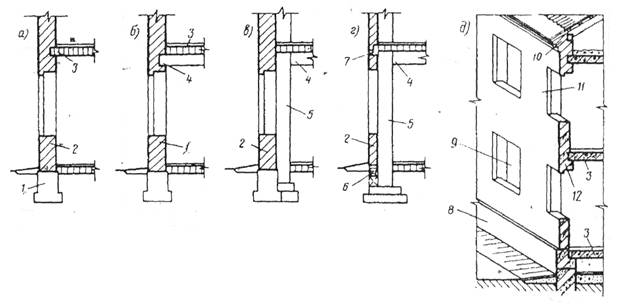
Figure 2.14 Wall structures: a - bearing in a frameless building; b - the same in a building with an incomplete frame; c - self-supporting; g - mounted; d - the main parts of the walls; 1- foundation; 2 - wall; 3 - overlap; 4 - crossbar; 5 - column; 6 - foundation beam; 7 - strapping beam; 8 - base; 9 - aperture; 10 - cornice; 1 - wall; 12 - jumper
In the frame one-story industrial buildingshaving large openings, a significant height and length of the walls, to ensure their stability, fachwerk is used, which is a reinforced concrete or steel frame that supports the walls, and also perceives the wind load and transfers it to the main frame of the building.
By design, walls can be solid, or layered.
Walls are the most expensive structures. The cost of external walls and internal is up to 35% of the value of the building. Consequently, the effectiveness of the constructive solution of the walls significantly affects the technical and economic indicators of the entire building.
When choosing and designing the construction of walls of civil buildings, it is necessary:
- reduce material consumption, labor intensity, estimated cost and cost;
- apply the most effective materials and wall products;
- reduce the weight of the walls;
- maximize the physical and mechanical properties of materials;
- use materials with high construction and operational qualities that ensure the durability of the walls.
In thermotechnical terms, the enclosing parts of buildings must meet the following requirements:
- provide the necessary resistance to the passage of heat through them;
- not have on the inner surface a temperature significantly different from the indoor air temperature so that near the fences there is no cold and condensation does not form on the surface;
- the possession of sufficient heat resistance (thermal inertia) so that the fluctuations in the external and internal temperatures are less reflected in the temperature fluctuations of the inner surface.
- maintain normal humidity conditions, because humidification reduces the heat-shielding properties of the fence.
Brick walls. The masonry materials are bricks: ordinary clay, silicate, hollow plastic pressing; hollow semi-dry pressing bricks. (Fig.2.15) When making a stack of bricks, their thickness can be different, depending on the climatic zone. So, in Almaty, the wall thickness is 510 mm (2 bricks), and for internal load-bearing walls - 380 mm (one and a half bricks) and even 250 mm. Ceramic hollow stones and small concrete blocks (e.g. 490x340x388) can be used. Brick grades 50 - 150.
Clay ordinary brick is produced with dimensions of 250x120x65 mm (88 mm) and has a bulk density of 1700 - 1900 kg / m 3.
Efficient clay bricks are hollow and lightweight. Volumetric mass of hollow brick 1300 - 1450 kg / m 3, lightweight 700 - 1000 kg / m 3 and more.
Silicate brick has a bulk density of 1800 - 2000 kg / m 3; Dimensions 250x120x65 (88 mm).
Slag brick has a bulk density of 1200-1400 kg / m 3.
Hollow ceramic stones differ from hollow bricks in terms of height (138, 188, 298 mm), shape and location of voids. Ceramic plastic pressing stones with 7 and 18 voids and have dimensions 250x120x138 mm, bulk density 1400 kg / m 3
Lightweight concrete stones there are continuous and hollow bulk masses of 1100 - 1600 kg / m 3.
The sizes of stones with slit-like non-through voids are 190x390x188 and 90x390x188, three-hollow -120x250x138 mm.
The best heat engineering indicators are stones with slit-like voids.
Front brick and stones are divided into profile and ordinary (solid and hollow).
Ceramic shaped plates are embedded and leaned.
In addition to ceramic products, concrete and other non-fired slabs and stones can be used for wall cladding. Natural stones and slabs of:natural stone is used for laying foundations and walls, for cladding (in the form of facing slabs, sawn, chipped, hewn, polished). Floors, window sills and staircases are also made of natural stone. Continuous masonry of ordinary brick and heavy stone materials is used in a limited way - where increased strength is needed, as well as in rooms with high humidity. In other cases, it is recommended; apply lightweight masonry.
Masonry is carried out on heavy (sand) or light (slag) solutions of grades 10; 25 - 50 and 100.
Continuous masonry is carried out according to the multi-row (spoon) or single-row (chain) system of dressing the seams, the laying of narrow piers (width not more than 1.0 m), as well as the laying of brick pillars, is carried out according to a three-row system. The thickness of the horizontal joints is taken equal to 12 mm, vertical 10 mm. To facilitate and warm the walls, wells filled with lightweight concrete are left in the wall.
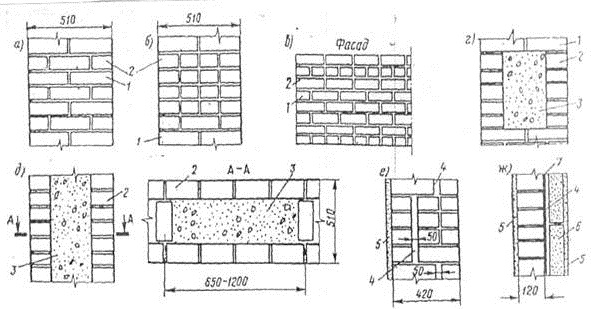
Figure 2.15 Walls made of bricks and ceramic stones: a - single-row; b - multirow; in - systems L.I. Onishchik; g-brick concrete; d-well; e- with an air gap; g - with stove insulation; 1- poke; 2 tablespoons; 3-lightweight concrete; 4-air layer; 5-plaster; 6-plate insulation; 7-grout.
Walls of large blocks. Buildings from large blocks are constructed without frames and with frames (Fig. 2.16.). By designation, large blocks are divided into blocks for external and internal walls, for walls of basements and socles, and special blocks (cornice, for bathrooms, etc.). Material for large blocks are lightweight concrete with a class of at least B5 (slag concrete, expanded clay concrete, cellular concrete, large-porous concrete, concrete on porous rubble) with a bulk weight of 1000; 1400 and 1600 kg / m 3.
Concrete blocks for external walls have a thickness of 300; 400 and 500 mm, for internal walls 300 mm. The outer surface of the blocks is billed with decorative concrete or tiles, and the inner surface is prepared for decoration.
Walls of large panels.According to the constructive solution, the panels are divided into single-layer and multi-layer (Fig. 2.17). Single-layer panels are made of lightweight concrete with a volume weight of up to 1200 kg / m 3, possessing the required frost resistance and heat-shielding qualities.
Multilayer panels (two-layer and three-layer) consist of a bearing shell that accepts all loads and insulation. The outer surface of the panels can be invaded with a decorative layer 20 mm thick on white and colored cement, coated with ceramic tiles, etc. The inner surface of the panels should have a finishing layer 10 mm thick.
The transfer of vertical forces in horizontal joints between panels represents the most difficult task of large-panel construction.
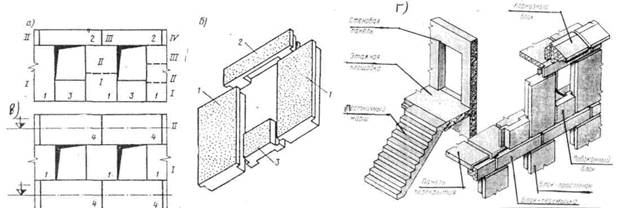
Figure 2.16. Large-block walls of civil buildings: a - two-, three- and four-row sections of the external load-bearing walls; b-basic types of wall blocks; c - double-row cutting of self-supporting walls; I, II, III, IV — rows of blocks; d — layout diagrams of blocks in a perspective view; blocks: 1- lining; 2 - jumper; 3 - window sill; 4-zone.
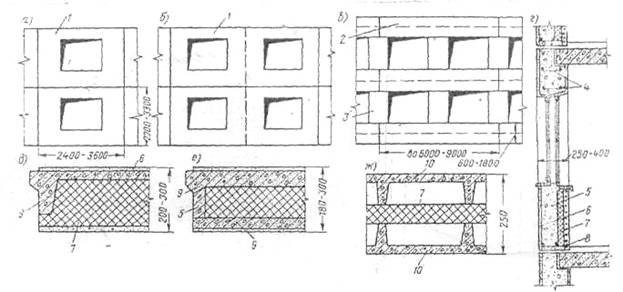
Figure 2.17 Panel walls of civil buildings: Section of the outer walls: a - single-row with panels on the room; b-the same in two rooms; c - two-row cutting of the panel structure; g-single-layer concrete; d - two-layer reinforced concrete; e - the same three-layer; g - from rolling plates; 1- panel with an aperture; 2- ribbon panel; 3- wall panel; 4 - reinforcing cage; 5 - lightweight concrete; 6 - decorative concrete; 7 - insulation; 8 - heating panel; 9 - reinforced concrete slab; 10 - rolling plate.
In practice, four main types of compounds have been used (Fig. 2.18.):
- platform joint, a feature of which is the support of the ceilings at half the thickness of the transverse wall panels, i.e. stepwise transmission of forces, in which the forces from panel to panel are transmitted through the supporting parts of the floor slabs;
- toothed joint, representing a modification of the platform-type joint, provides a deeper support for floor slabs, which, like a "swallow tail", rely on the entire width of the wall panel, but the forces from panel to panel are not transmitted directly, but through the supporting parts of the floor slabs;
- contact joint with the support of ceilings on remote consoles and direct transfer of forces from panel to panel;
- pin nest the joint with the support of the panels is also based on the principle of direct transfer of forces from the panel to the panel and the support of the ceilings through the consoles or ribs (“fingers”), protruding from the plates themselves and laid in slots specially left in the transverse panels.
Platform joint It is used for all types of nine-story houses, as well as experimentally - in 17-story and 25-story buildings with a narrow pitch of transverse load-bearing walls.

Figure 2.18 Types of horizontal joints between the supporting panels: a - platform; b-toothed; V-pin on remote consoles; g-pin nest
